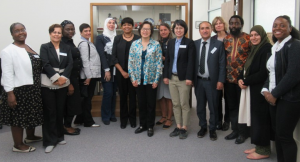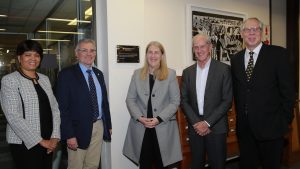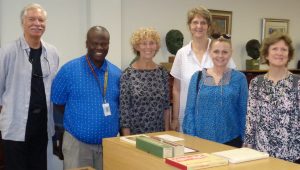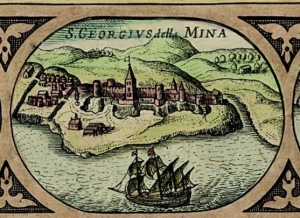From 18-26 May 2019, a team of four staff members from the Library and Information Service visited four institutions in the United States of America (USA). The purpose of the visits was to engage with libraries which have an established and substantial research data management (RDM) offering. Engagement with librarians in the USA who are working with researchers in terms of RDM services, training users, managing data repositories and are involved with various other RDM related activities, should provide essential insights and allow the Library to learn from their best practices.
The staff who participated in the visits were: Ellen Tise (Senior Director: Library and Information Service), Mimi Seyffert-Wirth (Deputy Director: Digital Scholarship), Samuel Simango (Manager: Research Data Services) and Marié Theron (Faculty Librarian: Science & AgriSciences). The four institutions visited were: The University of Illinois at Urbana Champaign, Purdue University, Carnegie Mellon University and University of California (Berkeley and California Digital Library).

The ultimate objective of the visits was to achieve proposed outcomes of the Library’s RDM strategic actions, which include the following:
-
- Librarians who are familiar with data management planning, data collection, processing and analysis, as well as data sharing, dissemination, curation and re-use;
- Preservation of and access to institutional research data;
- Insight into the role of researchers and the decisions they have to make regarding RDM.
Some of the many insights gained from the visits include:
-
- Libraries played a leading role in the establishment of research data services (RDS) on campus.
- RDS is integrated within the entire university community.
- RDS is a collaborative project between librarians, RDS partners and the academic community.
- Consultation and engagement with clients is crucial.
- Different types of data exist: raw data (size/sensitivity varies), processed data and analyzed data (repository); infrastructure and types of data can be matched.
- The Library should proceed with the implementation of RDS, based on a long-term (multi-year) roadmap (objectives, outcomes, actions, deliverables and target dates/phases).
After the informative visits, key library staff members were invited to an RDM session on 19 June to develop a roadmap for RDM at the Library and Information Service, Stellenbosch University.



 On 20 June 2019, the manuscript collection of the Institute for Democratic Alternatives in South Africa (IDASA) was handed over to Stellenbosch University (SU) by Her Excellency Mrs Helene Budliger Artieda, Ambassador of Switzerland to South Africa. The IDASA collection was acquired by SU with the financial support of the Swiss Confederation. The ceremony took place in the Special Collections division of the SU Library.
On 20 June 2019, the manuscript collection of the Institute for Democratic Alternatives in South Africa (IDASA) was handed over to Stellenbosch University (SU) by Her Excellency Mrs Helene Budliger Artieda, Ambassador of Switzerland to South Africa. The IDASA collection was acquired by SU with the financial support of the Swiss Confederation. The ceremony took place in the Special Collections division of the SU Library.
 “This has been an amazing journey. Switzerland is proud to be associated with this archive and these manuscripts. We have been working on this since late 2015. I’m happy that there will be a lasting memory at Stellenbosch University and that this collection is where it needs to be,” said Artieda during the handover.
“This has been an amazing journey. Switzerland is proud to be associated with this archive and these manuscripts. We have been working on this since late 2015. I’m happy that there will be a lasting memory at Stellenbosch University and that this collection is where it needs to be,” said Artieda during the handover.



 Also in attendance at the handover ceremony was Mr Paul Graham, former executive director of IDASA, who gave an overview of the history and significant role the organisation played in shaping South Africa’s democracy. He stated that IDASA was always committed to building capacity for democracy amongst citizens and their governments and is a model that is still worth following today.
Also in attendance at the handover ceremony was Mr Paul Graham, former executive director of IDASA, who gave an overview of the history and significant role the organisation played in shaping South Africa’s democracy. He stated that IDASA was always committed to building capacity for democracy amongst citizens and their governments and is a model that is still worth following today. The Library recently acquired online access to the Rand Daily Mail (RDM), a critically important newspaper that pioneered popular journalism in South Africa and was published daily in Johannesburg between 1902 and 1985. From its beginnings in 1902, the RDM was known for its controversial yet courageous journalism. Despite significant pressure from the conservative government, its writers openly addressed issues that white readers knew little about. This fully searchable online resource contains every article, advertisement, editorial, cartoon and photograph and offers a wealth of unique perspectives on 20th-century South Africa. It is expected to add considerable value to historical research on campus.
The Library recently acquired online access to the Rand Daily Mail (RDM), a critically important newspaper that pioneered popular journalism in South Africa and was published daily in Johannesburg between 1902 and 1985. From its beginnings in 1902, the RDM was known for its controversial yet courageous journalism. Despite significant pressure from the conservative government, its writers openly addressed issues that white readers knew little about. This fully searchable online resource contains every article, advertisement, editorial, cartoon and photograph and offers a wealth of unique perspectives on 20th-century South Africa. It is expected to add considerable value to historical research on campus.






 The Stellenbosch University Bellville Park Campus Library (USBL) has a new look and feel. Refurbishment of the USBL was completed in December and the Library now boasts a more spacious, brighter and welcoming look than before. There is a redesigned reception/information desk, two offices for the faculty librarians and new signage.
The Stellenbosch University Bellville Park Campus Library (USBL) has a new look and feel. Refurbishment of the USBL was completed in December and the Library now boasts a more spacious, brighter and welcoming look than before. There is a redesigned reception/information desk, two offices for the faculty librarians and new signage. The bookshelving in the Library is now mobile, allowing for changes in the use of the available space.
The bookshelving in the Library is now mobile, allowing for changes in the use of the available space.  A variety of seating options and study booths are available for users. These changes will facilitate your research, study and collaborative activities. If you have not visited the USBL, then a visit is in order. The motivated staff (who have a new staff room) will be pleased to welcome you.
A variety of seating options and study booths are available for users. These changes will facilitate your research, study and collaborative activities. If you have not visited the USBL, then a visit is in order. The motivated staff (who have a new staff room) will be pleased to welcome you.